By Tanner Cole
The sun is still rising, and the small front office of Trimble County High School is already crowded. There are 11 people standing in the building’s doorway, letting in the cool morning air. The Lady Raiders are the district and regional basketball champions, and now they’re shooting for the state title. These 11 folks are waiting to buy the last five available tickets to tomorrow’s basketball game, and some will be leaving unsatisfied. One woman reminds the office worker of all the times she volunteered to help with the cross-country team.
Two minutes down the road, the tellers at Bedford Loan and Deposit Bank are welcoming their first clients of the day. Of those individuals with bank accounts in Bedford, Kentucky, at least 80 percent bank here, according to its vice president Deanna Ralston.
“But a lot of people here are on fixed incomes,” Ralston says with a frown. “And they don’t bank with anyone.”
At the town community center, a red-roofed building with hardwood floors, Bedford’s city clerk Rita Davis sits on the far side of a little welcome window. She has a “Pennies for Puppies” can set out with a pixelated photo of a dog taped on. She’s wearing a gray and white shirt that perfectly matches the colors in her hair.
“The kids used to come down to the community center all the time,” she says, flipping through a phone book and rolling her eyes. “But now they’ve got those computers and phones. I don’t know what they do anymore. But they don’t come down here.”
She says that her town has become a rental community. The kids get older and move away. They’re not coming back anymore.
Behind Davis is an old door that reads “Todd Pollock, Mayor.” She describes him as a politician. She says politician like it’s a dirty word.
Out of every county in the nation, Trimble County, Kentucky, has the lowest percentage of people who believe in climate change, according to a 2014 Yale study. It may be the extreme example, but this is a culture that does not believe that the Earth’s climate is changing.
Pollock, the town’s mayor since 2014, is a sturdy looking man with a large forehead. He’s a freemason. He wants Donald Trump to be his president. When he isn’t tweeting his love for the Steelers, he’s using #SmallTownMayorSupportsTrump. It’s a lonely hashtag.
Pollock sits at a round table in the community center’s main gathering room. He isn’t surprised to hear that his county doesn’t believe in climate change. Sure, this state is full of registered Democrats, he says. But those Democrats vote for Republicans now.
“Global warming?” he says. “I don’t believe it’s settled. There is a change, but is it man-made or is it just the natural evolution of things? That I don’t think is quite determined.”
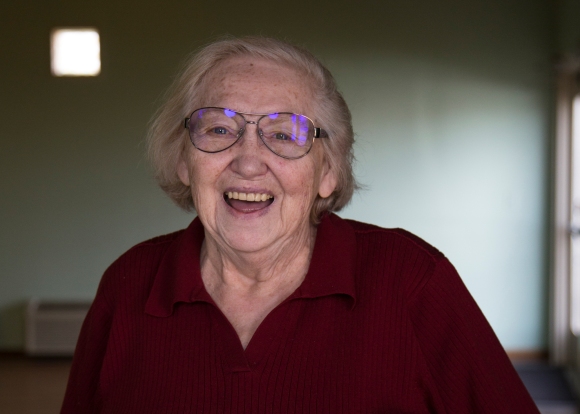
Photo by Jake Pope
Sitting at Pollock’s side is Hilda Parrish, the president of Trimble County’s historical society. She isn’t originally from Trimble, and she says it makes her an outsider despite living here for a decade. Parrish had to work to be accepted around here. In the meantime, she learned all about the county’s history.
She jabs a finger forward and opens her eyes wide as she recounts how residents of Bedford once rolled a whole church through the middle of town using wooden logs. She grows solemn as she recounts the Great Flood of 1937, which devastated the northern half of the county and had its former residents paddling rowboats to escape their rooftops. Scientists say climate change will lead to the Ohio River flooding worse and more often, but Hilda, who is clutching a pile of yellowed documents, doesn’t believe that the climate is changing.
“I have farming journals from a farmer that lived here in the county,” she says. “I have them from 1909 through 1943. I’ve looked at those, I’ve looked at the day temperatures and looked at the overall temperatures. There is no global warming.”
There’s an old, closed-down general store on the town square. It used to be the only grocery in town, but a few years ago Dollar General came to town and started cutting into its profits. A burst pipe and some debt put the place out of business soon after. But a new store called Poppy’s opened up down the road a few months back so there is another option again.
Customers are few and far between at Poppy’s this morning. The cashier is a young woman named Kristin Greenrose. She just started a few days ago.
“I mean, global warming says the whole planet is warming up and eventually we’ll all just burn up and die,” Greenrose says. “But people here go by the facts, and the fact is that we’ve had a couple real harsh winters around here, and that doesn’t add up.”
But the fact is that 97 percent of scientists agree that climate change is happening, likely because of human activities. Things like harsh winters don’t disprove their hypothesis — they’re evidence. Scientists say extreme weather events are one of the imminent dangers coming within a couple decades. In fact, Greenrose’s argument is one reason scientists say “climate change” rather than global warming.
Back at the community center, Mayor Pollock is about to get up to help one of his citizens clean out the basement. He’s describing the average citizen of Bedford. Though some things he said previously felt rehearsed, now his words feel very honest. Bedford residents are genuine, he says. They look out for each other. They’re family orientated. And they don’t like change, Parrish adds.
“They think when they get up in the morning and get out of bed, it will be Groundhog Day again,” she says. “People here want Groundhog Day.”
“She hit that spot on,” Pollock says, leaning back in his chair.
[su_dropcap style=”flat” size=”5″]A[/su_dropcap]n hour west of Bedford, Dr. Keith Mountain is clutching a book between his thick fingers. He is a formidable looking man with a heavy build. He has thinning, graying hair. He’s wearing a striped shirt, hiking boots and flimsy-looking glasses. And he is glaring down at this paperback book, gripping it as though he wants to tear it in half and muttering insults at it in his Australian accent.
It’s easy to look at climate science as a scary concept dreamt up by scientists who are far away. They’re disconnected from the real world by their lives in laboratories, unable to step outside and feel the sunlight, the sunlight that has not changed. But even experts here in the Commonwealth agree: this is happening, and it’s going to be bad.
The book in Mountain’s hands is “The Mad, Mad World of Climatism” by Steve Goreham. The cover pictures a group of polar bears driving around in a convertible with the roof down. Mountain says he threw it across the room the first time he started reading it. He didn’t order a copy, he says, it just showed up in his mailbox. The publisher recently mailed 100,000 copies of this book to environmental science professors across the nation, according to The Guardian. The newspaper also broke down Goreham’s falsified sourcing, scientific ignorance and blatant lying. But Mountain is an expert, and he didn’t need any of that to know it’s bogus.
“These groups do not do any firsthand research,” he says. “They will just take whatever information is out there and twist it into their own light. They are very good at creating doubt out of facts.”
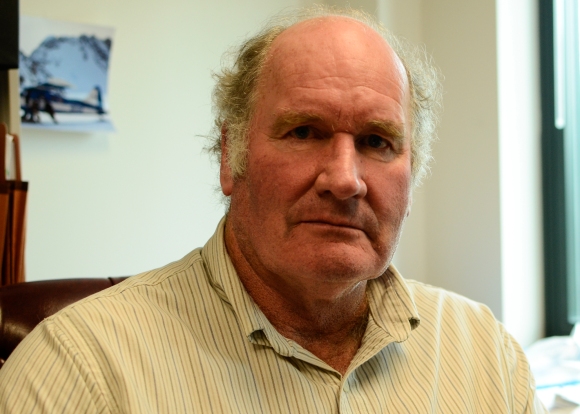
Photo by Tanner Cole
Mountain got into climate science long before it was a sexy, hot-button topic. He started back when it was a bit of an “arcane science,” he says, back when it would have been laughable to accuse someone of being in climate science for the money.
In the 1970s, he started joining group expeditions to glaciers all over the world. He developed an expertise with special drilling equipment that carves through miles of ice, unlocking a history of climate information. These studies go a lot further back than a local historian’s weather data collection — Mountain analyzes information from tens of thousands of years ago. This was the kind of research that first started cueing scientists in on climate change in the first place, and he’s been doing it ever since.
“I don’t stand to gain from this,” he says, laughing. “Hell, I don’t even have to do this. I can go drink beer anytime I want. I make my money from teaching, not from my research.”
Mountain is the department chair of geography and geosciences at the University of Louisville. His expertise is in climatology and climate change. Mountain is planning on retiring pretty soon, ending his career of worldwide glacier drilling. He thinks he’ll move to Alaska when he’s done and start building a house to avoid population density problems in the mainland United States, which he perceives as one of the biggest causes of climate change. He’s already figuring out how to live off the grid here in Louisville with the help of some ingenious students, and he thinks he’ll make it just fine in the cold.
Kentucky, according to Mountain, isn’t in great shape. Most of the world isn’t, for that matter.
There is no ambiguity. Humans are a major cause of climate change, he says. It isn’t guesswork anymore. People in Kentucky aren’t interested in the issue, so they don’t care. They don’t think of coal as a finite resource, he says, and the political structure reflects that ignorance. The challenge isn’t in providing evidence anymore. “How much more evidence could they ask for?” he asks, his voice rising.
“This is an issue that is not going to go away,” Mountain says. “It is here to stay.”
At the Louisville National Oceanic and Atmospheric Administration office, Senior Forecaster Tom Reaugh (whose last name is pronounced like a ray of sunlight) is working at a standing desk with five monitors. The screens display colorful maps, complicated menus and a whole lot of weather. Other forecasters are at similar stations scattered around the room.
“Carly endorses Ted Cruz,” one reads aloud.
“She was my girl,” another chimes in without looking up from his screens.
“I voted for Kasich here in town,” the first replies, his words trailing off.
These men monitor weather patterns constantly and send their findings out to news outlet across the region. The weathermen and women on local TV are usually getting their information from the folks in this room.
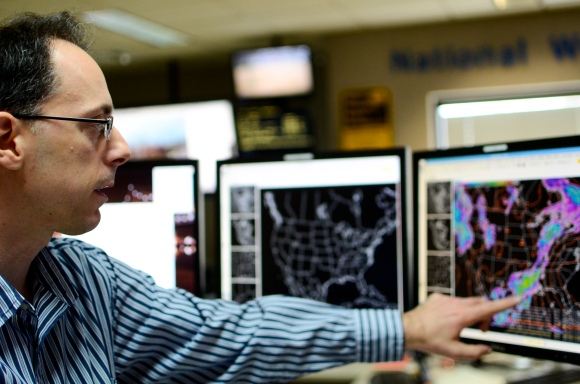
Photo by Tanner Cole
Reaugh retreats to his cubicle, where another two monitors wait for him. The left has his Gmail inbox open with the green grass background. The right has a photograph from the Kentucky derby set as its background. There is a tornado in the sky of the Derby image that Reaugh drew in using Microsoft Paint.
“That’s kind of my nightmare scenario there,” he says, nodding to the altered Derby pic. “Having that many people together in an emergency like that.”
Reaugh is a tall, skinny man with brown shoes. He identifies as a conservative. He regrets that, partisan-wise, climate change conflicts with the rest of his political stances. He is a weatherman, not a climatologist, and he is really concerned about adequately stressing the difference. However, everyone in the office has their own specialty side interest, and his is climatology.
With just a few clicks through well-traveled web pages, Reaugh pulls up a wealth of information.
Scientists at Oregon State University graphed global temperatures for the past 11,300 years. Their line slowly curved up and down along the climate trends of modern human history. But the end of the line turned vertical. The last century brought unprecedented global warming, roughly matching spikes of heat-trapping gas emissions.
NASA scientists checked out that last century. They found that all but one of the 10 warmest years in the last 134 have occurred since 2000.
In a recent report, the Intergovernmental Panel on Climate Change says that humans have changed the climate with greenhouse gas emissions, and that those changes are quickly transforming the natural world. They say that heat waves are on their way. They say we will soon face flooding, that our oceans will soon acidify and swallow our coasts.
“There is just overwhelming evidence that something is going on,” he says.
Two hours south of Louisville, Dr. Stuart Foster is sitting at his messy desk. It’s completely covered in papers, and they’re all facing different directions. A state map and a white board hang on the wall behind him.
Foster wears a green sweater with a blue shirt collar poking out the top. He has a weak smile that he flashes liberally. His thin bangs are cut in a straight line. Foster is the state climatologist for Kentucky and the director of the Kentucky Climate Center.
State climatologist used to be a busy job. The climatologist would monitor weather and climate patterns daily. Anyone whose industry relied on good weather would call the office asking for advice. Worried farmers could call in to check if their crops would survive the season, and an expert could explain the drought that would soon ravage their farmland. Nowadays, they have the internet for that. But Foster is still here watching the data.
And so far, there hasn’t been much of a sign of climate change affecting Kentucky. But that doesn’t suggest that it isn’t coming.
“There’s no reason to think that we’re going to miss out on it,” Foster says. “We’re just going to be later to the party. The fact that we have not yet seen significant change does not mean that we can just put our heads under the sand and say ‘that’s not an issue for us.’”
The hottest summer that young Kentuckians can remember will be the coldest summer their grandchildren could realistically hope for, he says. Floods are coming. Droughts are coming. And Kentucky’s fish will not be happy.
[su_dropcap style=”flat” size=”5″]T[/su_dropcap]wo men trudge onto the parking lot. They are dressed in camouflage. Each carries five trout on a string — the daily limit for fishers at Wolf Creek National Fish Hatchery’s trout stream. They drop the fish in a truck bed cooler then dump a bag of ice over top.
Inside the visitor center, a grinning, older gentleman hands a yellow snake to a group of teenage boys. They’re students on a tour from Foothills Academy, a school for troubled youth about 30 minutes away. Sometimes the school sends students here to pick up litter and lend a few hands on any work that needs doing, but today these boys are checking out the critters.
There’s a skunk sleeping in a cage in the lobby. The workers threw it a birthday party last week. An aquarium houses the species of fish that lost their homes when the dam was finished in 1951. They still live south of the dam in Lake Cumberland, but here on the northern side is trout country.
Kentucky’s entire trout population is grown here, but these trout aren’t even native to Kentucky. The hatchery was built to make amends for environmental damage dealt by the dam. Once the fish are around 9 inches long, workers will scoop them into buckets to dump them into delivery trucks. They will be sprayed out of the trucks through a metal pipe and into streams all over Kentucky.
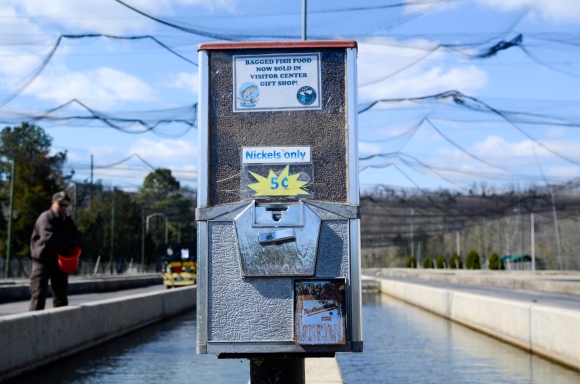
Photo by Tanner Cole
Trout are a coldwater fish. When temperatures at the deepest levels of Kentucky’s rivers and streams start to rise late in the summer, the ones still around all die off. Then, in the spring, this hatchery restocks the state’s waters with trout for the cycle to repeat.
But climate change may threaten this cycle, according to a climate change action plan published by Kentucky’s Department of Fish and Wildlife. Climate change means water temperatures will shift. Climate change means, for various reasons, fish kills. And fish kills mean swarms of dead fish washing downstream throughout the state; bumming out fishermen, endangering aquatic ecosystems and putting off a terrible smell.
The hatchery’s deputy project leader, Sheila Kirk, is standing at the end of a long, narrow “raceway” of flowing water. This particular raceway holds big, trophy trout. Two boys are feeding them brown pellets of fish food. It’s called a raceway because “the water races over the fish” Kirk guesses. She knows just about everything there is to know about this place, and it’s clear that her lack of confidence on this question is bothering her.
Kirk has shoulder-length brown hair and a Tennessee drawl. She’s wearing a khaki shirt with a brown Fish and Wildlife cardigan. She watches as the trout jump for the two boys.
“The warmer the water gets the less survival we’re going to have,” she says. “These fish just can’t take it. Their ideal temperature is 50-55 degrees. That’s where you get the best growth, the best survival and the best disease resistance. So what are we going to do when the water is 20 degrees warmer?”
Kentucky’s natural wonder will erode if climate change continues unchecked, according to the Department of Fish and Wildlife.
The whirring, flapping buzz of bat wings in Mammoth Cave, the world’s largest cave system, will slowly fade away as bat populations lose their roosting nests. Warmer temperatures will spread diseases like White Nose Syndrome through the bats, killing even more.
There’s a type of endangered salamander that people call Hellbenders that may not be able to migrate out of their stream ecosystems in time to survive. Other lizards and frogs will lose their breeding habitats to invasive species, flooding water and changing temperatures.
The crayfish that young boys overturn rocks searching for in the Green River could soon be all but gone. Birds that never belonged in Kentucky before could start showing up, confused by shifting migratory patterns, to start wrecking havoc on current food chains. Bald Eagles could stand to lose their wintery Kentucky roosts.
But that’s just looking at animals.
A 2015 report by Risky Business, a research group founded by former New York City Mayor Michael Bloomberg, former U.S. Secretary of the Treasury Hank Paulson and liberal billionaire philanthropist Tom Steyer, says that Kentucky will experience the third largest crop losses nationally. Corn, soybean, grain and oilseed crops will take dramatic losses. The report says that heat deaths in Kentucky will increase by hundreds. The economic impact, it says, will be devastating.
Another report, this one published by the University of Kentucky’s agriculture department in 2011, says that global warming will continually create an increasingly unpredictable place to grow crops. Pests will start surviving the milder winters, and livestock will struggle in hotter summers.
Some trees will fade away from Kentucky forests, and some will grow stronger, according to a 2015 report on Southeastern forests and climate change by Kentucky State University. The Kentucky forests of tomorrow will not look like the state’s forests today.
Wendell Berry, a famous environmentalist writer and Kentucky native, is often asked to provide a predicted glimpse into the future of his beloved country and state. In his book of essays “Our Only World,” Berry addresses the question in an essay titled “On Being Asked for ‘A Narrative for the Future’.”
“None of us knows the future,” he writes. He muses that trying to make predictions is usually a waste of time, for even when their sentiment is right, the details are usually wrong. But there’s a caveat.
“If we take no thought for the morrow, how will we be prepared for the morrow?”
[su_dropcap style=”flat” size=”5″]T[/su_dropcap]he historic downtown square in Somerset, Kentucky, is covered with classic hot rods. A speaker system strung up from building to building blares oldies tunes. A high school couple is taking prom photos with a line of cars in the background. People are crowding around a bright yellow 1970 Ford Mustang Mach One with magnum wheels. It costs $10 to enter for a chance to win the $30,000 vehicle. Its license plate reads “WIN ME.”
A man announces through the intercom that the hot rod cruise is about to begin. He says 1,200 cars rolled into town today for the first Somernites Cruise of the summer. He says to enjoy the drive and to make sure to come back in a month for the next one.
All six lanes of nearby Highway 27 are full of cars. The sides of the road are lined with people in lawn chairs. It is about 7 p.m. now, and these cars will drive up and down this stretch of road in an endless loop until the early morning hours. In the end, it’s some 7 or 8 hours of pure emissions.
An old muddy truck passes by with a confederate flag waving out the back. A souped-up red corvette with tinted windows speeds through. An old Chevrolet follows with big General Motors stickers plastered on its doors. There’s a brand new, yellow Camaro. There’s a pristine, black Silverado 2500HD resting atop a tow truck’s rear bed. An older couple wearing matching bandanas whiz by on a lime green motorized tricycle. And a different, muddy truck with yet another confederate flag drives on through.
Back in the square, Philip and Ella Wellman are waiting for the crowd to roll out before moving their 1956 Chevy Nomad. “House of the Rising Sun” by The Animals is playing from the event’s speaker system. They only made 8,600 of this model, Philip brags from his lawn chair. “It’s part of the family now,” he says.
Philip believes that the climate is changing, but he doesn’t think people have anything to do with it.
“Every now and then you hear about these record-setting temperatures,” he says. “Oh it was this hot in 1910 too? I wonder what was causing it then, farting horses?”
A sprawling conference center in Bowling Green, Kentucky, is filled with Republicans lining up to cast their ballots in Kentucky’s presidential caucus. A man in a black “Make America Great Again!” shirt is hunched over a table, checking a box next to the name of a reality television personality.

Photo by Tanner Cole
Voters drop their ballots in a big cardboard box guarded by a lone member of the local Republican Party. He looks bored, but he turns on a smile whenever someone walks up.
Randy Scarboro, a man with a conservative haircut and a fleece sweatshirt, is filling out a ballot for Ted Cruz with the help of his two kids.
“Climate change?” he says waving his hand as though he’s trying to bat the concept away from him. “I’m not concerned with that at all.”
They say the Kentucky coal mines are running dry, but Muhlenberg County, Kentucky, is still producing tons of the stuff. The first commercial coal mine ever dug in Kentucky was burrowed here in Muhlenberg by a man named William McLean. He called the bits of coal he dug up “black rocks,” and he sold them as such.
McLean’s community, Paradise, Kentucky, was eventually bought by the Tennessee Valley Authority after reports came out that emissions from the nearby Paradise Fossil Plant were poisoning its people. Paradise was lost in 1967, two years after Muhlenberg became the No. 1 coal producing county in the nation. A few years earlier in 1962, the Peabody Coal Company built what at the time was the world’s largest shovel, weighing 14 million pounds, for a mining site in Muhlenberg.
Today, the Paradise Fossil Plant — with its three huge cooling towers pumping smoke, its network of coal chutes and its platoon of heeping semi trucks — supplies energy for a million homes. Two-thirds of the plant will shut down in 2017 and be replaced with natural gas burning facilities.
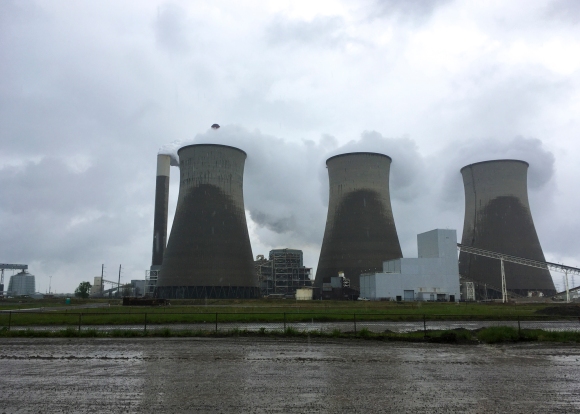
Photo by Tanner Cole
In Greenville, the county seat, statues of pickaxe-wielding coal miners stand on a terrace in front of the courthouse in the center of town.
Across the street, the local library has a book on display called “Coal Mining Equipment at Work” by Michael D. Davis. In the book’s introduction, Davis writes: “So many times we forget that Coal is what made this country what it is. Without it, we have no electricity, no cars, no trains, no buildings — nothing. It’s the fundamental building block of everything we see and use in society.”
On the opposite side of the courthouse a plaque memorializes John Prine’s song “Paradise.” The sign has a photograph of Prine, printed lyrics to his song and a button one can press to listen to it.
“And Daddy won’t you take me
back to Muhlenberg County
down by the Green River where
paradise lay.
Well, I’m sorry my son, but you’re too late in asking
Mister Peabody’s coal train has
hauled it away.
Then the coal company came with
the world’s largest shovel
and they tortured the timber and
stripped all the land
Well, they dug for their coal till the
land was forsaken
then they wrote it all down as the
progress of man.”
With coal energy being a prime target in the environmentalist war on carbon emissions, Kentucky’s long history of coal dependence creates a uniquely climate-science-resistant state culture. Much of Kentucky still does not believe in climate change, even as its coal mines appear steadily less fruitful.
Ellen Peters, a professor of psychology at The Ohio State University, says that providing evidence and challenging deniers to supply their own is the answer to changing people’s opinions. People have their assertions, she says, and challenging them will lead them to the truth.
“We have these confirmation biases that seem to be driven by selective exposure to information and selective perception of information,” Peters said in a recorded Feb. 2016 lecture titled “Why We Don’t Believe Science.”
In Kentucky, it’s hard to talk politics without those cultural confirmation biases getting in the way, and their names are coal, politics and ignorance.
A 2015 study published in Nature Climate Change details the complex linkage between climate change denial publications and organizations and the network of fossil fuel industry figures that fund them.
With the Obama-backed and heavily contested Clean Power Plan set to impose increasingly strict restrictions on coal burners for the next decade-and-a-half, Kentucky is being forced to rethink its energy infrastructure.
In 2016, Kentucky is officially a red state on both the national and state level, and the modern Republican Party is the party of climate change denial. Last year, for instance, Jim Inhofe (R-OK) brought a snowball into senate chambers as proof that climate change isn’t real. But in Kentucky, coal is so ingrained in the culture that even the Democrats fight regulation. Gov. Matt Bevin is a climate science denier, but his Democratic opponent for the governor’s seat last year, Jack Conway, was launching a lawsuit as Attorney General against the Environmental Protection Agency during his campaign.
On the Republican side, the denial is robust. In 2014, Kentucky state Sen. Brandon Smith said that climate change isn’t caused by coal plants because Mars is warming too. Last year, Mitch McConnell started attacking Obama’s international efforts to curb climate change. So far, the Bevin administration has raided the Kentucky Land Conservation Fund, granted a $18 million tax cut to the construction of a life-size, biblical ark (owned by the same company as the climate science-denying Creationist Museum) and appointed a previous coal executive, Charles Snavely, to head the Kentucky Energy and Environment Cabinet.
Snavely calls himself a climate change “skeptic.” His plan for Kentucky involves moving from coal energy to natural gas — an environmental improvement, but fracking isn’t much better than mountaintop removal to many experts.
“If I’ve got to pick climate change or feeding my family, then I’m going to pick feeding my family,” Snavely said after explaining that climate change isn’t a priority in his decision making for Kentucky’s energy plan.
[su_dropcap style=”flat” size=”5″]I[/su_dropcap]t is a rainy afternoon in Bowling Green, Kentucky, but so far it looks like everyone is still showing up for the Kentuckians for the Commonwealth dinner. Folks are shaking off umbrellas inside the doorway before heading into the main room to find their seats. They’re here to discuss alternatives to Snavely’s energy vision for Kentucky.
The dinner event, called “A Seat at the Table,” is starting soon. It’s being hosted in Corsair Distillery, a local operation that makes specialty whiskeys and other drinks. Guests are finding seats at large, circular tables covered in green-and-white table cloths. There is a three-piece bluegrass band — sporting one cowboy hat and two beards — playing in the front of the room. They stop playing as the organizers start speaking, and the three bow their heads along with the rest of the room for a pre-meal prayer.
This is the first of several Seat at the Table events being held around the state. The events offer a free meal to Kentuckians in various cities in exchange for a lively discussion of Kentucky’s energy future. Come listen to a few speeches on clean energy, then eat a spinach-and-artichoke quiche, they say.
A server is handing Justin Druen, a 35-year-old from Hardin County, a platter of vegan tamales to pass around the table. Druen has a 5-inch, wiry beard on his chin and a size-8 fishhook strung through the rim of his baseball cap. He hasn’t made his mind up yet on Kentucky’s energy situation, and he has his reservations. “This country was built on coal,” he says. “Why do we need to change?”
Other tables host professors, farmers and business owners. The food is all locally sourced, and a lot of it is being quickly devoured. Lisa Abbott, a KFTC organizer, is speaking now and the lights are being dimmed for a slideshow. She’s showing illustrations of folks from all over the state, one per slide, and telling us their stories. There’s a retired coal miner who is pushing for clean energy in his mountain community. There’s a concerned mother who is worried about air pollution. There’s a home builder looking to improve his craft and save his conscience. Abbott tells the room that Kentucky has all of its egg in one basket — coal.
“Having all of our eggs in one basket can seem like a good arrangement for a while,” she said. “But when things begin to change — and especially if the change is sudden — it leaves us vulnerable.”
Then, as folks are devouring slices of pecan pie, she dives into the facts.
Ninety-two percent of Kentucky’s electricity comes from coal, she says, compared to 39 percent for the rest of the country. The Energy and Environment Cabinet — headed by Snavely — wants that number at 65 percent by 2020, and its already dropping. But they’re planning on filling the gap with natural gas plants, and virtually no solar or hydro power. Meanwhile, utility costs will keep increasing.
Clean energy, she says, is the cheapest and healthiest option for Kentuckians. And with the federal Clean Power Plan on the horizon, the Commonwealth is either going to start changing now or face the economic consequences soon enough.
She’s done talking, and the room is starting self-facilitated discussion.
One man has a hand reached as high as he can stretch it, and his other is imitating water pouring down from it. He’s describing a system to draw energy from water running off Eastern Kentucky mountaintops.
Billy Ray, the superintendent of the nearby town of Glasgow’s Electric Plant Board, is showing his table an energy usage chart he brought along. “This is physics,” he says. “This is science. This is not and should not be politics.”
There is a man named Tim Taylor who is wearing a lot of khaki and denim. Back in the day, his dad set a record time for shoveling 2,000 pounds of coal. But today Taylor says, “It’s time that we move to a more sustainable future.”
Everyone is getting up to leave, and Druen says he’s made up his mind now. He’s worried, because he doesn’t really think wind or solar power sources are economically viable. But he agrees that Kentucky needs a new plan.
“I don’t know what, but I think that’s what we’re all here for,” Druen says. “If we had an easy solution to clean energy, we wouldn’t need this conversation.”
There’s a network of people and organizations trying to change Kentucky from itself. Either the state’s culture or its climate will change first, and groups like Kentuckians for the Commonwealth are gunning for the former. Other organizations, such as the Kentucky Environmental Foundation, the Sierra Club and the Kentucky Student Environmental Coalition, are doing similar things.
It is Earth Day, and it is chilly in Lexington, Kentucky, but that isn’t stopping the University of Kentucky Green Thumbs, an local organization that operates under KSEC.
Outside the university’s administrative building, the Thumbs are standing in a cluster with a microphone. They’re chanting. The involved students are wearing matching green shirts, and their thumbs are painted green. But several other students are joining in for the shouting.
Some Thumbs are walking around with iPads. One wears the club’s green shirt with a pair of pajama pants. “Hi, would you like to sign our petition?” he asks.
Tyler Worthinton, 25, would like to sign it. He’s wearing an unbuttoned plaid shirt with a t-shirt underneath. He’s frustrated with the lack of change from the university administrators. He’s worried that the university ties to the coal industry run too deep.
“On the one hand, there are students here that do care,” he says, gesturing toward a group of students holding up a banner with “Listen to your students!” printed across it. “But there is an administration that has other motives.”
Caroline Engle is struggling with her cell phone to get music to play through a speaker. As it starts blaring the words “Pump up the jams!” the crowd cheers and she smiles over her shoulder at them.
Engle is a Green Thumb veteran. She’s served in leadership positions within the organization for years. The Green Thumbs are the oldest student organization in the state, and its mission has adapted to the times and interests of its students. With Engle’s influence, the group has worked for years now to get their university to adopt a climate action plan and switch the school’s energy sourcing away from coal. And that’s what today’s protest is all about.
Engle studies natural resources and environmental science, economic policy and sustainable agriculture at University of Kentucky. She has brown hair and eyes and wears a nose ring. She has a silver ring on her right hand with a tree engraved on it that she bought it during her sophomore year to remind herself to be strong and resilient just like the tree. Her Green Thumb shirt is very wrinkled, but she has a backup t-shirt in her backpack with the words “COAL SUCKS” printed on it.
“Coal in Kentucky has always been destructive,” she says. “It’s always been polluting. The industry has never really genuinely cared about the state of Kentucky. When you look at the top coal producing mines, the towns around them are incredibly impoverished. There are food deserts. There are drug problems. There are poor education systems. To say that those communities are being built up by the coal industry is a complete lie.”
Engle has attended two United Nations summits as a delegate for Kentucky’s environmentalist Sierra Club.. Engle’s family is full of coal miners, and she’s seen firsthand its effect on communities and the environment. This state needs cultural change before it can change from the top levels, she says. Given the state’s close association with coal, she thinks it can become a clean energy leader.
“Kentucky is uniquely positioned to really send serious changes across the United States and world for really getting our stuff together and taking this issue seriously,” Engle says.
[su_dropcap style=”flat” size=”5″]T[/su_dropcap]he sun is starting to set on Berea, Kentucky, so some students at Berea College are outside basking in the last light of the afternoon.
Gina Dittmeier, of Louisville, is sitting cross-legged under a tree outside the campus library. She’s painting water color pictures of the trees around her. Dittmeier believes in climate change, and she believes that it’s caused by people.
“Maybe some people just like to stay ignorant,” she says. “Some people just don’t like change. They don’t want to stop waving their confederate flags around.”
There’s a disconnect between the rather progressive Berea College and the surrounding town, but the college’s impact and generous scholarships for underprivileged arts students bring diversity to the town’s intellectual discourse.
In the 1850s a rich abolitionist named Cassius Clay sold modern day Berea lands for extremely low prices. He wanted to develop a new community that would demonstrate how beautiful Kentucky could be without slavery. Berea College was developed primarily to educate newly emancipated slaves. The college’s second bylaw still states that “This college shall be under an influence strictly Christian, and as such opposed to sectarianism, slaveholding, caste, and every other wrong institution or practice.”
If Trimble County is a glimpse into a Kentucky that denies science, Berea could be a vision of a sustainable alternative for the state that is still authentically Kentucky, just as it was a vision of liberty some 150 years ago.
There is a dorm on Berea College’s campus called the Deep Green Residence Hall. The building has solar-paneled roofs, recycled bricks and student-built furniture.
The area around the city today is lush with farmland and full of folks living sustainably off the grid. Scharme Price, at the Berea Welcome Center outside the town’s arts and crafts collective community, says the town’s sustainability isn’t a modern, trendy thing, or even a response to climate change — sustainable living is ingrained in the culture here.
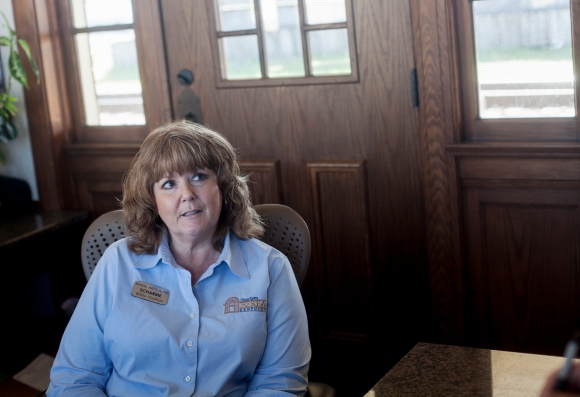
Photo by Morgan Hornsby
“We had this diverse group working on this solar energy thing together,” she says from behind the center’s front desk. “They were people from really progressive churches and really old fashioned churches, and you see them and think they must hate each other. But they could come work on solar things together and get along together.”
Of course, not everyone in town believes. Jeff Hayes, the owner of Berea Fudge Shoppe, is standing behind the counter wrapping up a fudge-covered Twinkie. He has long, brown hair, a short beard and a rather intense look on his face. They’re closing up for the day soon.
“I think climate change is a bunch of bull crap,” he says. “I think the regulation of everything is killing everything. I mean, Obama already killed the coal industry, too.”
His wife enters the store from sweeping outside. She is smiling as she approaches, but her face turns to a frown then quickly to a glare as she hears Hayes’ words. “I’ve heard all the stuff about the ice caps melting and all that,” he says. She stops short of the counter and stares, catching his eyes. His intensity quickly dies down.
“But I don’t have anything else to say on all that.”
Then again, Berea isn’t known for people like Hayes. It’s known for its artisans. It’s known for people like Gerald Price.
Price is a metalsmith and subsistence farmer. He specializes in bronze working. He’s one of the last artists around this afternoon in the Berea Guild of Artists and Craftsmen space. Price stands in the lobby near a display of his bronze pieces. He’s showing potential customers a little fish keychain. He uses the misshapen ones as sinkers when he goes fishing, he says and chuckles.
Price says he’s neutral politically. Cities stress him out, so he lives outside of town on his farm with no running electricity or water. He has two goats, seven guinea fowls, two cats, 10 chickens and three ducks. It is difficult to distinguish where his brown hair ends and his mangy beard begins. He wears a camouflage hat and wide lensed glasses.
And this man, who lives off the grid, drives an old Ford F-150 and really only comes to town to work in this art studio, believes in climate change.
“Sure, we have to have power,” Price says. “You can’t just shut down the coal plants. But climate change is pretty scary. We are going to have to deal with it eventually.”